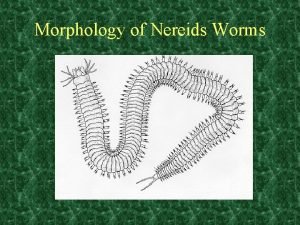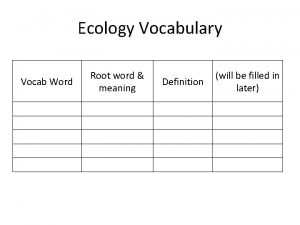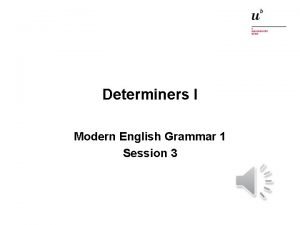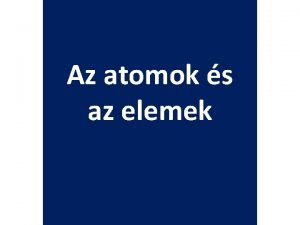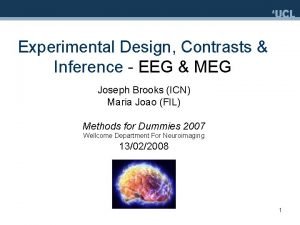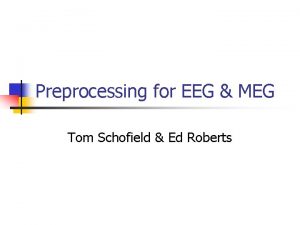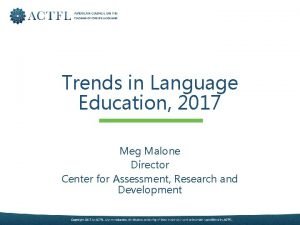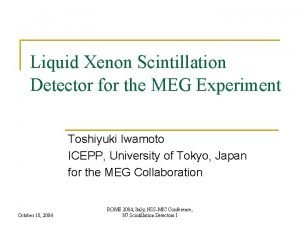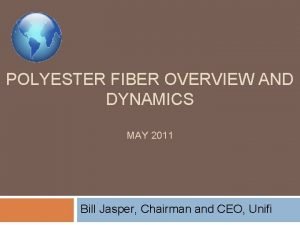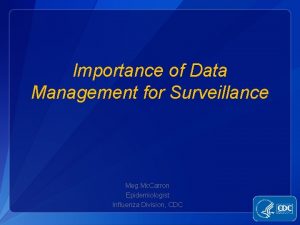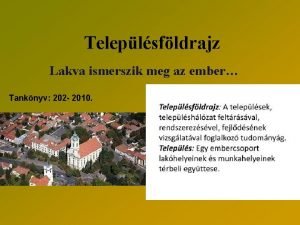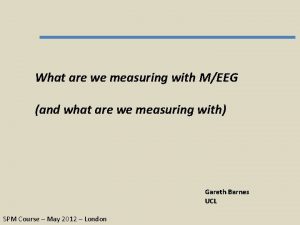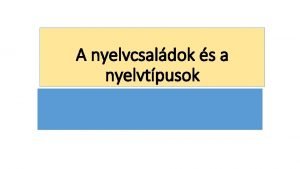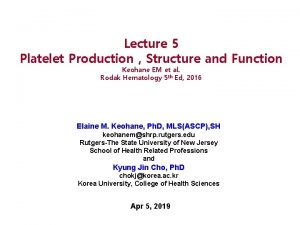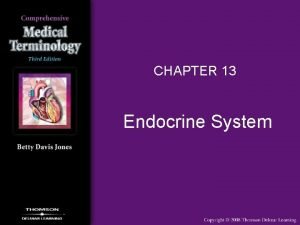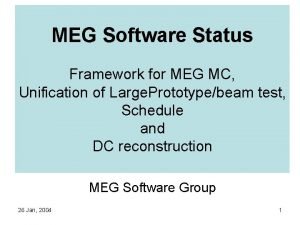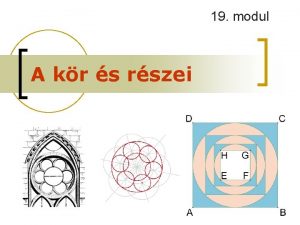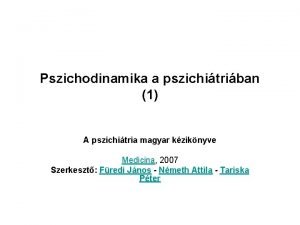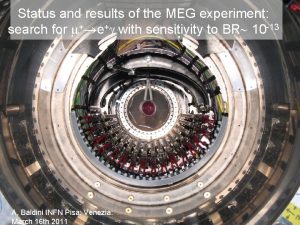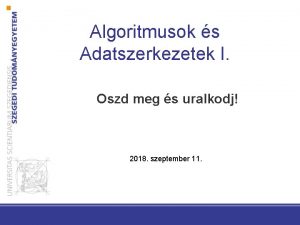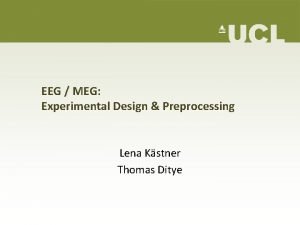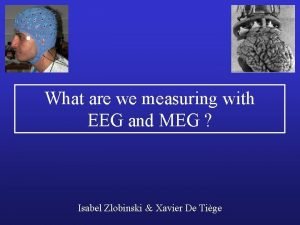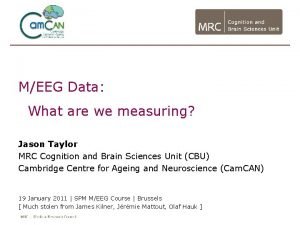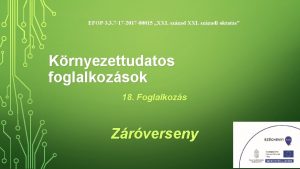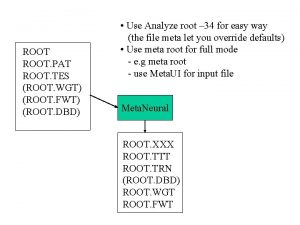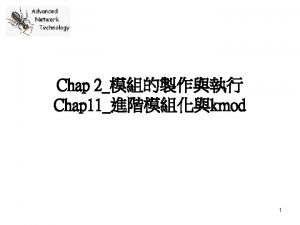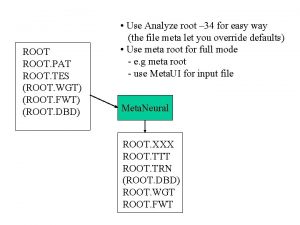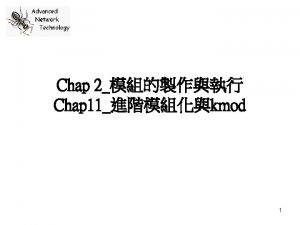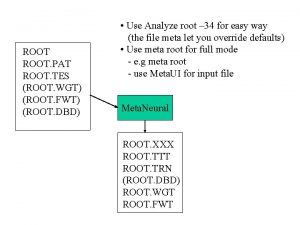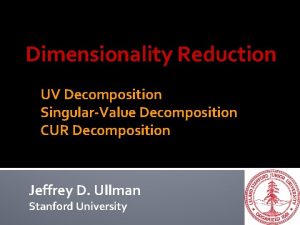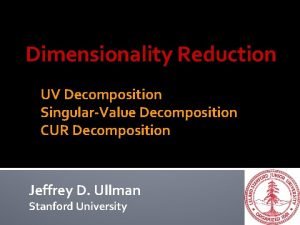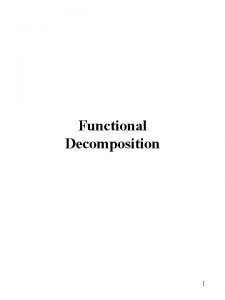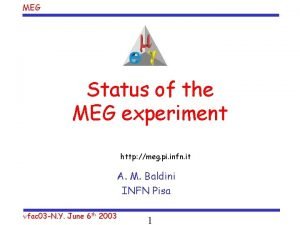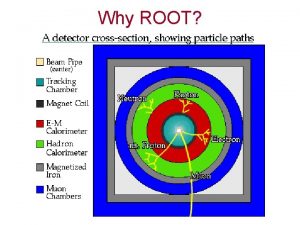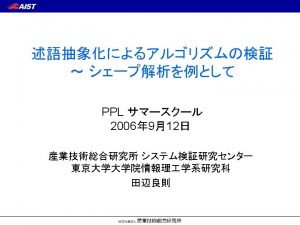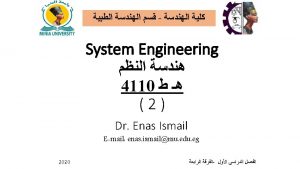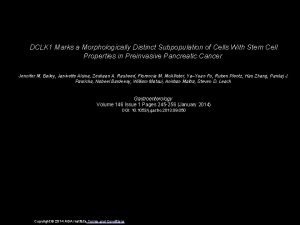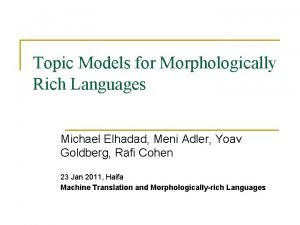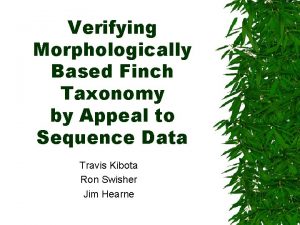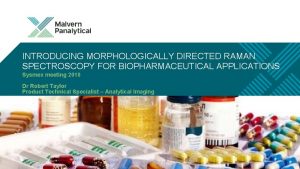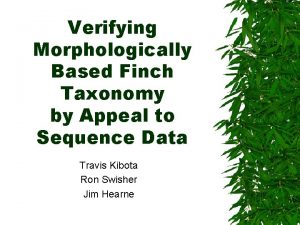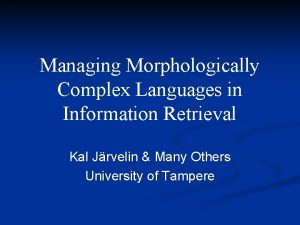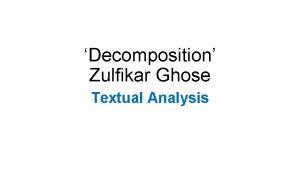Decomposition to the Root MEG Studies of Morphologically









































































- Slides: 73

Decomposition to the Root: MEG Studies of Morphologically Complex Words Alec Marantz Olla Solomyak, Ehren Reilly NYU Depts. of Linguistics and Psychology KIT/NYU MEG Joint Research Lab

Decomposition to the root (why the morphologist cares about lexical access) • Claim associated now with Distributed Morphology: – all “lexical categories” decompose at least to a root and a category-determining affix – all relations between words or morphemes (e. g. , blocking relations) are computed at the syntactic level of terminal nodes. Thus a single item (e. g. , undecomposed irregular past tense “gave”) cannot “compete” with a complex structure (e. g. , [give [pst]]) (Embick & Marantz 2008) – the grammar itself demands full decomposition to the root – the existence of “whole word” roots to lexical access or processing would necessitate a different grammatical system for processing language as opposed to, say, computing grammaticality

Decomposition to the root (why the morphologist cares about lexical access) • Tracking the “ami” in “amiable, ” then, is one step along the way toward understanding how the root “cat” functions inside “cat” adj √ami n adj -able √cat n ø

(Overly) Simplified Models of Lexical Access: Pinker’s Words and Rules • Full storage model: all complex words (walked, taught) stored and accessed as wholes – only surface frequency effects predicted – Reaction Time (RT) correlates with the surface frequency of a complex word • Full decomposition model: no complex words stored and accessed as wholes – only stem frequency effects predicted – RT correlates with the frequency of the stem of a complex word, not the frequency of the word as a whole (surface frequency)

• Dual Route Model (Pinker’s): irregular complex forms (taught) are stored and accessed as wholes; regular complex forms (walked) are not: – surface frequency effects for irregulars (and high frequency regulars) = RT to taught correlates with freq of taught, not teach – stem frequency but no surface frequency effects on access for regulars = RT to walked correlates with freq of walk, not walked

• There are Stem Frequency effects in access for complex words – RT to walked does correlate with freq of walk • These effects are not attributable to postaccess decomposition

• But, surface frequency effects in lexical access are found in wide variety of cases, including completely regular morphology (e. g. , for most inflected words in Finnish)

E. g. : • Surface frequency effects even for transparent productive regular morphology like -less and for same words that yield base frequency effects – surface frequency effects when surface frequency is varied and base frequency is held constant – base frequency effects when base frequency is varied and surface frequency is held constant

Additional Problems for Pinker-style Dual Route Model • The representation of irregular derived or inflected forms must be complex – from the grammatical point of view, gave is as complex as walked • no further affixation: *the gaving, *the walkeding (note: Pinker’s appeal to irregular plurals inside compounds highlights his incorrect prediction here – mice eater, but *micey (mousey)) • alternations with do support: Did he walk/*walked, Did he give/*gave

– from the psycho and neurolinguistic point of view, irregulars contain the stem in the same way that regulars do • taught-teach identity priming in long-lag priming (only identity (“morphological”) relations - not semantic nor phonological - survive in long distance priming) • and for M 350 brain response (e. g. , Stockall & Marantz 2006) – taught-teach M 350 (~N 400) priming equivalent to identity priming, although RT priming is reduced

Whole Word “Representations” for Regulars, if Surface Frequency effects imply whole word representations (in some sense) • Surface frequency effects on access are seen for a variety of completely regular derivations and inflections, implying whole word representations, in some sense • Obligatory decomposition: – surface frequency effects could be tied to decomposition (the more you’ve decomposed a particular letter/sound sequence into stem and affix, the faster you are at it) and/or – recombination (the more often you’ve put together a particular stem and affix, the faster you are at it) – in either case, against Pinker’s dual route model, such effects imply representation of whole word as complex structure, regardless of regularity

• walked may “stored” as a complex form with a certain frequency in the same way that a saying like, And now for something completely different, is • That is, any surface frequency effect may be connected to long-term effects of having computed a complex form and thus imply a “representation” of the complex form, no matter how regular • This “usage-based” account of frequency effects holds no immediate implications for the grammar of morphologically complex words, nor for the issue of whether all complex words are recognized via decomposition (and recomposition)

Encyclopedia Stored info about encountered items (outside language system) “And now for something completely different” [un[real]] White House UN+REAL (? ? ) lemma (lexical entry) “not” modality specific access lexicon un REAL unreal (? ? ) real (visual word form) form code (letters) u n r e a l interactive dual route models and obligatory decomposition models differ on the possible presence of complex word forms in modality specific access lexicons, and perhaps on whether derived forms have “lexical entries”

Differences Between Realistic Dual Route Model and Realistic Full Decomposition Model • Both models require a (modality specific) word form “lexicon” – for full decomposition model, this lexicon holds only forms of morphemes – for dual route model, this lexicon holds some morphologically complex forms • Dual Route but not Full Decomposition model allows whole word lexical entries and word form entries for morphologically complex forms

Stages of Lexical Access: which computations in a Full Decomposition Model affect RT? • I. Decomposition (affix-stripping): no general effect on RT – Taft: cost-free – Literature: no evidence that ease or difficulty in affix stripping generally correlates with change in RT – MEG studies (to be discussed): brain activity correlated with decomposition does not correlate with RT (more brain work associated with decomposition does not yield longer RTs)

• II. Lemma access: frequency of “lemma” (stem) correlates with RT – Lemma (stem) access is modulated by frequency and by priming – Morphological family size of a stem and number of related senses (polysemy) have been shown to modulate brain activity associated with lemma access at the same brain time/place (the “M 350”) as stem frequency – However, the relationship between an affix and a stem for a morphologically complex word has not been shown to affect the same brain response

• III. Recomposition: surface frequency statistics correlate with RT because of their role in determining the ease of recomposition of stem and affixes – So, whole word “representations” (in the sense of “Encyclopedia” storage or simply in the sense of repeatedly used neural pathways) are accessed via decomposition and recomposition, where the surface frequency properties of these representations exert a late influence on lexical access

Sequential processing of words

Sequential processing of words Pylkkänen and Marantz, 2003, Trends in Cognitive Sciences

Latency of M 350 sensitive to lexical factors such as lexical frequency and repetition: reflects stage of lexical access Frequency (Embick, Hackl, Shaeffer, Kelepir, Marantz, Cognitive Brain Research, 2001) Repetition (Pylkkänen, Stringfellow, Flagg, Marantz, Biomag 2000 Proceedings, 2000)

Full Decomposition Model Related to MEG response components • M 100 (“Type I” Tarkiainen et al. ) response from primary visual areas – visual feature analysis • M 130 (“Type II”) response from occipital-temporal junction – abstract letter string analysis • M 170 (“visual word from area”) response from fusiform area – affix stripping and functional morpheme identification – visual word form recognition

Regions of interest derived from peak activity in grand averaged data across subjects

• M 350 (early “N 400 m”) response from temporal lobe, with possible (likely) contribution from inferior frontal cortex – lemma activation • Post-M 350 N 400 m response from temporal lobe (and other regions) – recombination of stem and affix, contact with Encyclopedic knowledge, integration into context

Statistical Connections between Stem and Affix • J. Hay proposes that the transition probability of the affix given the stem (so, from stem to affix) should correlated with ease of decomposition - the higher this probability, the harder the decomposition and the more “affix dominant” a complex word is

• The transition probability of the stem given the affix (from affix to stem), on the other hand, could reflect the ease of recomposition. – Note that for all but the most frequent regular English past tense verbs, the probability of the stem given the past tense suffix is vanishingly small. – If RT that seems to correlate with surface frequency is actually correlating with the transition probability from affix to stem, this could explain why regular formations in English do not show surface frequency effects unless the frequencies are very high.

Transition Probabilities & Affix dominance tokens of “merely” tokens of words containing “mere” transition probability from stem to suffix correlates with ratio of a suffixed word’s frequency to frequency of words with the same stem, which is essentially equivalent to “affix dominance” tokens of words with -ly transition probability from suffix to stem correlates with ratio of a suffixed word’s frequency to the frequency of words with the same suffix

hypothetical example: matched for stem frequency (9), difference in surface dominant (mere(ly)) or stem dominant (sane(ly)) • • • mere merely merely • • sane sane sanely

Effect of “Dominance” on Lexical Access: view from interactive dual route model • Hay: affix dominance leads to difficulty in parsing/decomposition, thus reliance on whole-word recognition and suppression of decomposition in favor of whole-word route • So, words with high affix dominance should not be recognized via decomposition and should show only surface frequency effects

Taft (2004): “Morphological Decomposition and the Reverse Base Frequency Effect” Obligatory decomposition makes similar predictions as interactive Dual Route model for RT in lexical decision • Base frequency effects… • RT to complex word correlates with freq of stem • …reflect accessing the stem of morphological complex forms whereas • Surface frequency effects… • RT to complex word correlates with freq of complex word • …reflect the stage of checking the recombination of stem and stripped affix for existence and/or wellformedness.

How can we distinguish these accounts of RT differences? • With brain evidence for the various stages of lexical access leading up to the RT – Interactive dual route models: no base frequency effects at lexical access for affix-dominant words – Full decomposition: base frequency effects across affix- and stem-dominant words at lexical access followed by surface frequency effects in RT associated with recombination Reilly, Badecker & Marantz 2006 (Mental Lexicon):

Experiment: parallel behavioral and MEG processing measures • Lexical Manipulation (Baayen, Dijkstra & Schreuder, 1997, JML) – Lemma/stem frequency (CELEX database) – Stem vs. affix dominance Stem Frequency: Stem Dominant= low surface freq Affix Dominant= high surface freq High desk – desks crop – crops Mid deck – decks cliff – cliffs Low chef – chefs chord – chords

Stimuli: 3 Lexical Categories fully productive morphology • Nouns: singular/plural – bones • Verbs: stem/progressive – chopping • Adjectives: adjective/-ly adverb – clearly

Experiment: behavioral measures • Reliable effect of stem frequency in RT in lexical decision

Experiment: behavioral measures • Interacting effects on RT of affixation (base vs. affixed) and dominance (base-dominant vs. affixdominant) This is a surface frequency effect for completely regular morphology. Same words, both base and surface frequency effects, undermining Pinker theory

M 350 sensors chosen subject by subject

Analysis of M 350 peak latency (brain index of lexical access) • Reliable effect of Stem frequency for unaffixed words and for affixed words Unaffixed Words Affixed Words

Analysis of M 350 peak latency • No effect of Dominance (base-dominant vs. affixdominant) - no effect of surface frequency - on M 350 peak latency – Against prediction of interactive dual route theory

Analysis of M 350 peak latency • No interaction between Dominance (base-dominant vs. affixdominant) and Affixation (base vs. affixed) Behavioral RT M 350 peak latency

Analysis of M 350 peak latency • Evidence that early stages of access for affixed words is based on full parsing: Stem frequency affects M 350/lexical access while whole word frequency affects post-access (recombination) stage of word recognition.

But what about evidence for parsing and recombination? RMS Correlations Across Subjects • For some set of sensors, calculate at each time point in each experimental “epoch” the root mean square (RMS) = the square root of the mean of the squares of the values at each sensor (after normalization of values) • So, for each subject, for each item, an RMS “wave” can be provided for the correlational analysis • At each time point, the RMS value for each stimulus is correlated with a stimulus variable

Grand Average All Stimuli All Subjects (11)

M 170 sensors chosen on the basis of field pattern, subject by subject

M 170 Correlation with Dominance: Significant “parsing” effect The higher the transition probability from stem to affix, the higher the M 170 amplitude – for affix-dominant words

Recombination Effect? : Correlation with Conditional Probability of Stem, Given Affix, for Affixed Words at 450 ms, after the M 350

Summary of Dominance Exp • Base and Surface Freq RT effects for same words again argues against simplistic (Pinker) Dual Route theory • Affix dominance effect at M 170 for high affix dominant words argues against Hay’s interactive Dual Route theory, where such words should be accessed via the whole word route – as does lack of M 350 latency effects for these words • M 350 latency effects for stem frequency but not surface frequency (and not affix dominance) followed by effect of transition probability from affix to stem post M 350 argues that recombination dominates RT effect for surface frequency of affixed words

Evidence for an orthographic word form lexicon • Frequency of stem relative to full affixed form – affix dominance – correlates with M 170 amplitude; implies access to some kind of stem representation • Zweig & Pylkkänen (2008) show M 170 effect of decomposition in the contrast between farmer (complex) and winter (simple), where the contrast implies access to a representation of farm at the M 170 (wint lacks a representation)

Zweig & Pylkkänen (2008, LCP) Bimorphemic: farmer, Monomorphemic Orth: winter

Modality-Specific Access Lexicon? • Pulvermüller in a number of studies has found early (~150 ms) word frequency effects in evoked brain responses in the posterior brain regions • These are found for monomorphemic words, and the effects seem limited to shorter words • These could be explained by higher order n-gram frequencies - by the frequencies of letter strings, i. e. , by features of word form representations that do not make contact with the (semantic) lexicon

Modality-Specific Access Lexicon? • “Parsing” at the M 170 requires access to word forms (or to high-n n-grams) • Dominance effects at the M 170 suggest frequency information associated with word-forms – dominance reflects the conditional probability of the affix given the stem, where notion of “stem” implies form representation of the stem • Difference between visual word form representation and lexical entry? – heteronyms like “wind” (“moving air” vs. “twist”) – visual word form frequency is not the same as lexical frequency – “wind” has one word form frequency but two lexical frequencies, one for each meaning

Lexical access in early stages of visual word processing: A single-trial correlational MEG study of heteronym recognition Marantz & Solomyak (2008, Brain & Language) • All (20) monomorphemic heteronyms (meeting other criteria) of English • If M 170 marks access to visual word form representations, but not lexical entries, then only form frequency variables associated with heteronyms should correlate with M 170 brain activity • If M 170 marks lexical access, relative frequency of the 2 pronunciations of heteronyms should correlate with activity


Regions of interest derived from peak activity in grand averaged data across subjects

Visual Word Form Area Left Hemisphere — Ventral View • The white point represents the peak of the Visual Word Form Area, as identified by Cohen et al. (2002) • The yellow line outlines the region of peak M 170 activation in an average of 9 subjects’ brain activity.

Mean Activity in LH M 170 Region for 9 Subjects (Dotted line shows average across subjects)

Grand averaged activation over time from M 170 and M 350 ROIs

Only the form property (~bigram frequency) showed significant correlation with brain activity in the M 170 ROI while only the semantic property (ratio of frequency of meanings) showed a significant correlation in the M 350 ROI A Monte Carlo procedure was used to test for significance in the face of multiple comparisons (across time points)

Evidence so Far • Decomposition even for “affix-dominant” words – evidence at M 170 that high transition probability between stem and affix makes affix-stripping harder – evidence post-M 350 and at RT that surface frequency makes recomposition easier

• Evidence for “visual word form lexicon” accessed at M 170 – transition probability effects at M 170 depend on frequencies over word form representations – complexity effects at M 170 (Zweig & Pylkkänen) depend on wint vs. farm word form contrast: farm is a word form but wint (in winter) isn’t

• Evidence that word form effects involve word forms, not lexical entries – open bi-gram frequency (representational form for word forms) correlates with activity at M 170 – but frequency ratio for heteronyms doesn’t correlate with activity at M 170 – but does correlate with activity at M 350

What about the status of bound stems? Can MEG help settle a disputed linguistic issue • Bound stem: durable – same root in duration – predicts durability • Unique stem: amiable – no other uses of root – but, predicts amiability

tracking the -able in amiable • If words like durable with a recurring root and amiable with a unique root nevertheless are parsed and computed as is workable with a free root, then – M 170 “parsing” effects should be visible for these “opaque” words, since effects are strong for affixdominant words – M 350 effects should be observed for stem frequency for bound stems

Crucial contrasts: • To show effect of affix processing, need to show correlation with, e. g. , affix frequency that is not equally explained by the positional frequency of the letters at end of the affixed word – distinguish “able” as affix from “a-b-l-e” • To show effect of “parsing variable” transition probability of affix given the stem, need show correlation with transition probability that is not equally explained by the transition probability between the last letters of the stem and letters of the suffix.

Categories of Affixed Words for New Experiment • 1. Free Root-Affix – taxable • 2. Bound Root-Affix – tolerable • 3. Unique Root-Affix – capable • Morphological parsing as from English Lexicon Project

Nine Affixes (All derivational suffixes in English that yielded reasonable number of examples for each category) • able • ary • ant • ity • ate • ic • er • al • ion

The ROIs determined again from the grand average across subjects.



Decomposition Effects at M 170 • Positional letter string freq effects at M 130 • Affix freq effects but no letter string effects at M 170 • Morph trans probability effects but no orthographic trans probability effects at M 170 – Multiple regression, taking out first (non-significant) orthographic parsability leaves significant effect of morphological parsability at M 170

Summary • At M 130, form property of final letter frequency correlates with activity • At M 170, affix frequency but not final letter frequency correlates with activity for all groups, including bound and unique root groups • At M 170 transition probability between stem and affix, but not between last letters of stem and letters of affix, correlates with activity for both free and bound stems • At M 350, stem frequency effects for both free and bound root stems

bound stems • For transition probability results, bound stems pattern with free stems • For affix frequency results, all stems, including unique bound stems, pattern alike • Thus we find evidence for full decomposition for free, bound, and unique stems

Conclusions • All evidence massively disconfirms a Pinker-style dual route theory in which some morphologically complex words are recognized as undecomposed wholes • Full Decomposition theories of lexical access are completely consistent with (in fact predict) surface frequency effects for morphologically complex words • Surface frequency effects reflect statistics of composition rather than the frequency of whole word access

• MEG data confirm the existence of a visual word form lexicon that enters into morphological decomposition in the recognition of complex words • MEG confirms the morphologist’s claim that decomposition extends to bound and unique roots

Thanks to the audience and the colloquium organizers!
 Morphologically vermiform/worm-shaped, unsegmented.
Morphologically vermiform/worm-shaped, unsegmented. Decomposer root word
Decomposer root word Paradigm shift from women studies to gender studies
Paradigm shift from women studies to gender studies Tiborc panasza vers
Tiborc panasza vers The meg
The meg Klór elektronszerkezete
Klór elektronszerkezete Character analysis examples
Character analysis examples Space stats
Space stats Hasisolaj
Hasisolaj Meg schofield
Meg schofield Meg malone
Meg malone Psixe
Psixe Mit mutat meg a periódusszám
Mit mutat meg a periódusszám Meg
Meg Meg aubrey
Meg aubrey Meg mc
Meg mc Boldog ember az
Boldog ember az Nátrium elektronhéjak száma
Nátrium elektronhéjak száma Lakva ismerszik meg az ember
Lakva ismerszik meg az ember Jer tárjunk ajtót még ma mind
Jer tárjunk ajtót még ma mind Meg hourihan
Meg hourihan Kort presentasjon av meg selv eksempel
Kort presentasjon av meg selv eksempel Meg
Meg Nyelvtípusok
Nyelvtípusok Voltmérő leolvasása
Voltmérő leolvasása Megakaryoblast
Megakaryoblast Isten áldja meg a magyart kotta
Isten áldja meg a magyart kotta Thigh royd
Thigh royd A wrinkle in time meg character traits
A wrinkle in time meg character traits Sistema meg
Sistema meg Ambigurity
Ambigurity Körszelet területe
Körszelet területe Aszkétizmus
Aszkétizmus Meg whitman biography
Meg whitman biography Beal moodle
Beal moodle The meg bts
The meg bts Carol gilligan
Carol gilligan Meg alexandra designs
Meg alexandra designs Eeg photo
Eeg photo Oszd meg és uralkodj algoritmus
Oszd meg és uralkodj algoritmus Ha te jézust követed
Ha te jézust követed Lena meg
Lena meg Meg
Meg Eeg meg
Eeg meg Meg stone etsu
Meg stone etsu Oszd meg és uralkodj
Oszd meg és uralkodj A napfénytől nagyon félnek csupán sötét égben élnek
A napfénytől nagyon félnek csupán sötét égben élnek Làm thế nào để 102-1=99
Làm thế nào để 102-1=99 Thế nào là mạng điện lắp đặt kiểu nổi
Thế nào là mạng điện lắp đặt kiểu nổi Mật thư anh em như thể tay chân
Mật thư anh em như thể tay chân Lời thề hippocrates
Lời thề hippocrates Vẽ hình chiếu đứng bằng cạnh của vật thể
Vẽ hình chiếu đứng bằng cạnh của vật thể Tư thế worms-breton
Tư thế worms-breton Quá trình desamine hóa có thể tạo ra
Quá trình desamine hóa có thể tạo ra Khi nào hổ con có thể sống độc lập
Khi nào hổ con có thể sống độc lập Các châu lục và đại dương trên thế giới
Các châu lục và đại dương trên thế giới Dạng đột biến một nhiễm là
Dạng đột biến một nhiễm là Nguyên nhân của sự mỏi cơ sinh 8
Nguyên nhân của sự mỏi cơ sinh 8 Bổ thể
Bổ thể độ dài liên kết
độ dài liên kết Thiếu nhi thế giới liên hoan
Thiếu nhi thế giới liên hoan điện thế nghỉ
điện thế nghỉ Tia chieu sa te
Tia chieu sa te Hát lên người ơi
Hát lên người ơi Một số thể thơ truyền thống
Một số thể thơ truyền thống Sơ đồ cơ thể người
Sơ đồ cơ thể người Công thức tính thế năng
Công thức tính thế năng Số nguyên tố là gì
Số nguyên tố là gì đặc điểm cơ thể của người tối cổ
đặc điểm cơ thể của người tối cổ Tỉ lệ cơ thể trẻ em
Tỉ lệ cơ thể trẻ em Các châu lục và đại dương trên thế giới
Các châu lục và đại dương trên thế giới ưu thế lai là gì
ưu thế lai là gì Tư thế ngồi viết
Tư thế ngồi viết Thẻ vin
Thẻ vin
